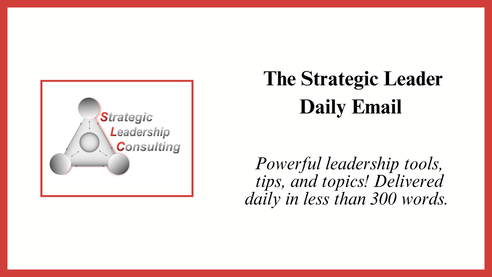|
Colleagues,
The chances are good that several remarkable individuals helped you to develop your leadership skills. Pause and take a moment to think about them and be grateful. And now it is your turn. Who are you developing? It’s easy to talk about building someone’s leadership capacity, but how do you actually do it? Here are three strategies that work together to help develop leadership:
The hardest thing about growing leaders is being intentional about it, but that’s also what is so cool! You can grow others’ leadership; you just need to be thoughtful and prioritize it. Before you get on with your busy day, how about taking a minute to reach out and thank that person who was intentional about helping you grow? If that person is no longer with us, then think about the part of them that lives on in you and be grateful. Do good and be well, Frederick
0 Comments
Colleagues, Today we conclude our series on the leader as gardener. Fall is harvest time, the time to profit from the investments you’ve made in the garden. Perhaps your harvest will be consumed as it is gathered, it might be given away, or maybe it will be stored for winter. The bearing of fruit by people (the outcome of their growth) is similar. Sometimes those seeds result in things that improve the organization or make your leadership easier. Other times the produce goes somewhere we don’t access. We may not be the ones to enjoy, but our gardening has made a difference to the person and others somewhere else. It may be that the product is put up for some other time in the future. Again, we may not be there to witness the final impact. I’m thinking about providing some specific examples next week, but maybe it is time to let this ground fallow! Reflect on people who planted seeds in you. What story can you tell, and what was the fruit? Again. I love getting your feedback, so share your questions or stories here. Do good and be well, Frederick Colleagues,
Yesterday we planted a seed, today we will take care of it. My garden needs water almost every day. Sometimes it rains, but other times I need to water it myself. For leaders, watering is the metaphor for interacting with people and nurturing those seeds on a daily basis. There are two basic strategies for doing that. First, act as if. Act as if the seed had already grown and was bearing fruit. The 18-19th century German philosopher Goeth said, "Treat people as if they were what they ought to be and you help them to become what they are capable of being." This is the essence of providing daily water. Sometimes the soil becomes depleted and plants need a boost, so we add fertilizer. Fertilizing is an intentional process provided at just the right time. By being consistently present with people, we can tell when the opportunity to fertilize occurs. One powerful way to fertilize is to provide responsibility for a task related to the seed you have planted. Provide enough support to promote success, but enough space to encourage growth. You don’t need to wait until a person is 100% ready as long as you provide adequate support. What task can you provide to someone that will help them make that big leap in growth? Do good and be well, Frederick Colleagues,
We’ve talked about preparing to plant seeds by preparing the soil and how that corresponds to creating an organizational environment with minimal turbulence. Now it is time to talk about seeds. We could spend a week just on this aspect of the leader as a gardener, but we will focus on one simple idea: it isn’t up to you to choose what seed to plant. Please take a moment to reflect on this. It isn’t up to you to choose what seed to plant. I love avocados, but they are not going to grow in my climate. So how do you know what seed to plant? Listen to the people in whom you will be planting seeds. In his incredible 1971 treatise, On Caring, Milton Mayeroff said that if we really care about someone, we help them grow in the ways in which they need to grow. We take their lead in the process, in contrast to us trying to remake them in our image or turn them into what we want them to be. When we listen closely, people will tell us what they need and what they are ready for. They may not do it consciously and they may be unaware of it themselves, but in being present and listening, leaders gain insight into the needs of those they serve. Last week I asked you to think about people in whom you could plant seeds. Think about those people now, and reflect on their needs, and how they have communicated them to you. Do good and be well, Frederick Colleagues,
This week we are looking at leadership through a gardening analogy. Yesterday we talked about the importance of knowing your garden and planning (read it here). Today, we’ll look at preparing the soil. Seeds will grow almost anywhere, but they will grow better in soil that meets the specific needs of the seed. Poor soil conditions create stress on seeds and plants. At best, they will survive without reaching their potential and at worst they will die. Stressed plants will be less resilient to environmental changes and more susceptible to disease and insect attacks. Gardner’s prepare soil by balancing acidity, creating a loose mix, and adding nutrients. How does this transfer to leadership? We can think of soil as being the environment our people work in. A poor environment is like poor soil in which people, and your efforts to grow them, will not be productive. My good friend Steven Gross used the paradigm of flying conditions to describe four levels of organizational health, which he called Turbulence Theory:
For leaders, creating a healthy organization with mild turbulence is the best way to create an environment in which people can grow. We can also apply turbulence theory to people’s personal lives, with the same implications for growth. So, how turbulent is your organization and the lives of the people within it? What can you do to “prepare the soil” by decreasing organizational stress? Do good and be well, Frederick |
Categories
All
Archives
July 2024
|


 RSS Feed
RSS Feed